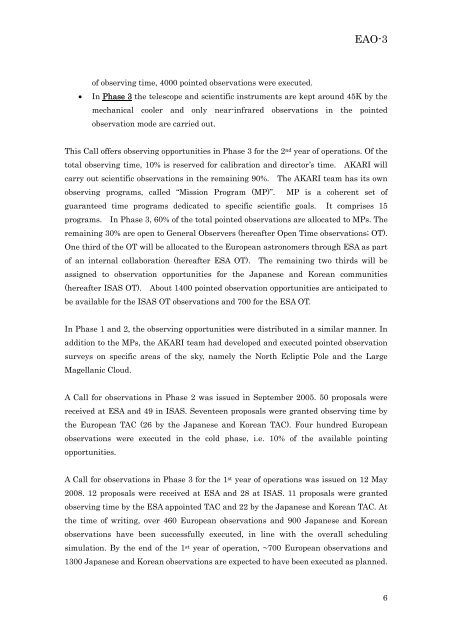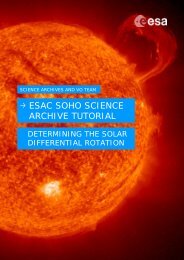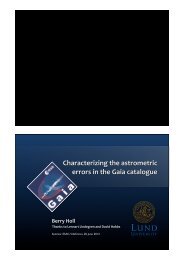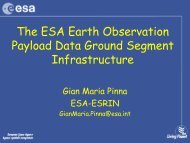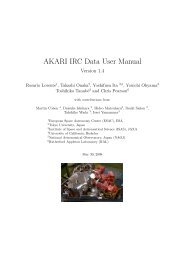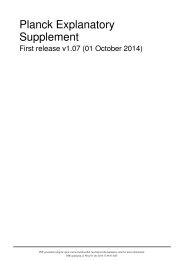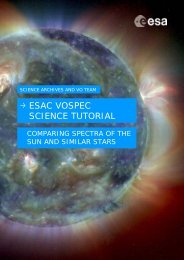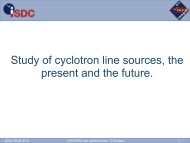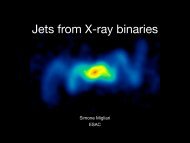1 Announcement of Opportunity AKARI (ASTRO-F) CALL FOR ... - ESA
1 Announcement of Opportunity AKARI (ASTRO-F) CALL FOR ... - ESA
1 Announcement of Opportunity AKARI (ASTRO-F) CALL FOR ... - ESA
- No tags were found...
You also want an ePaper? Increase the reach of your titles
YUMPU automatically turns print PDFs into web optimized ePapers that Google loves.
EAO-3<strong>of</strong> observing time, 4000 pointed observations were executed.• In Phase 3 the telescope and scientific instruments are kept around 45K by themechanical cooler and only near-infrared observations in the pointedobservation mode are carried out.This Call <strong>of</strong>fers observing opportunities in Phase 3 for the 2 nd year <strong>of</strong> operations. Of thetotal observing time, 10% is reserved for calibration and director’s time. <strong>AKARI</strong> willcarry out scientific observations in the remaining 90%. The <strong>AKARI</strong> team has its ownobserving programs, called “Mission Program (MP)”. MP is a coherent set <strong>of</strong>guaranteed time programs dedicated to specific scientific goals. It comprises 15programs. In Phase 3, 60% <strong>of</strong> the total pointed observations are allocated to MPs. Theremaining 30% are open to General Observers (hereafter Open Time observations; OT).One third <strong>of</strong> the OT will be allocated to the European astronomers through <strong>ESA</strong> as part<strong>of</strong> an internal collaboration (hereafter <strong>ESA</strong> OT). The remaining two thirds will beassigned to observation opportunities for the Japanese and Korean communities(hereafter ISAS OT). About 1400 pointed observation opportunities are anticipated tobe available for the ISAS OT observations and 700 for the <strong>ESA</strong> OT.In Phase 1 and 2, the observing opportunities were distributed in a similar manner. Inaddition to the MPs, the <strong>AKARI</strong> team had developed and executed pointed observationsurveys on specific areas <strong>of</strong> the sky, namely the North Ecliptic Pole and the LargeMagellanic Cloud.A Call for observations in Phase 2 was issued in September 2005. 50 proposals werereceived at <strong>ESA</strong> and 49 in ISAS. Seventeen proposals were granted observing time bythe European TAC (26 by the Japanese and Korean TAC). Four hundred Europeanobservations were executed in the cold phase, i.e. 10% <strong>of</strong> the available pointingopportunities.A Call for observations in Phase 3 for the 1 st year <strong>of</strong> operations was issued on 12 May2008. 12 proposals were received at <strong>ESA</strong> and 28 at ISAS. 11 proposals were grantedobserving time by the <strong>ESA</strong> appointed TAC and 22 by the Japanese and Korean TAC. Atthe time <strong>of</strong> writing, over 460 European observations and 900 Japanese and Koreanobservations have been successfully executed, in line with the overall schedulingsimulation. By the end <strong>of</strong> the 1 st year <strong>of</strong> operation, ~700 European observations and1300 Japanese and Korean observations are expected to have been executed as planned.6


